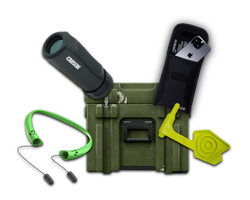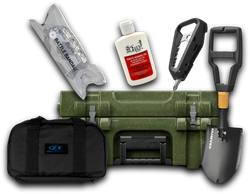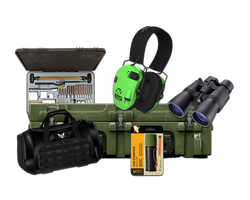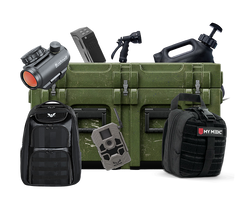How to Choose a Sleeping Bag: The Ultimate Guide for Outdoor Enthusiasts
Table of Contents
- Introduction
- Understanding Insulation Types
- Temperature Ratings
- Shapes of Sleeping Bags
- Features to Consider
- Sizing Your Sleeping Bag
- Testing Your Sleeping Bag
- Crate Club: Your Source for Tactical Gear and Sleeping Bags
- Conclusion
- FAQ
Introduction
Imagine spending a night under the stars, surrounded by the soothing sounds of nature, yet feeling utterly miserable because you were unprepared for the chill in the air. The difference between a restorative night’s sleep and a shivering sleepless ordeal often boils down to one critical piece of gear: the sleeping bag. The right sleeping bag not only keeps you warm but also ensures comfort and enhances your overall outdoor experience.
With a plethora of options available, choosing a sleeping bag can feel overwhelming, especially for newcomers to camping or experienced adventurers looking to upgrade their gear. The significance of selecting the appropriate sleeping bag cannot be understated—your comfort and safety depend on it. This guide aims to equip you with the necessary knowledge to make an informed decision when selecting a sleeping bag that suits your needs.
In this article, we will explore various aspects of sleeping bags, including types of insulation, temperature ratings, shapes, features, and considerations for specific conditions. We will also highlight how Crate Club’s subscription services can help you discover high-quality sleeping bags and essential gear tailored to your outdoor adventures.
By the end of this guide, you will be empowered with the insights needed to choose a sleeping bag that fits your unique requirements and enhances your camping experience. Let’s dive in!
Understanding Insulation Types
When it comes to sleeping bags, insulation is a crucial factor to consider. The insulation type affects weight, warmth, compressibility, and overall performance. There are two primary types of insulation used in sleeping bags: down and synthetic.
Down Insulation
Down insulation is derived from the soft feathers of ducks or geese. It is highly regarded for its warmth-to-weight ratio and compressibility. Here are some key advantages and disadvantages of down insulation:
Advantages:
- Lightweight and Compressible: Down sleeping bags are lighter and can be packed down to a smaller size, making them ideal for backpacking trips where weight is a concern.
- Excellent Insulation: Down provides superior warmth, even in extremely cold conditions, allowing you to stay comfortable at lower temperatures.
Disadvantages:
- Water Sensitivity: Down insulation loses its insulating properties when wet, and it can take a long time to dry. This makes it less suitable for wet environments unless treated with waterproofing.
- Cost: Down sleeping bags generally come with a higher price tag due to the cost of the material and the manufacturing process.
Synthetic Insulation
Synthetic insulation is made from man-made fibers designed to mimic the insulating properties of down. Here are the pros and cons of synthetic insulation:
Advantages:
- Water Resistance: Synthetic sleeping bags retain their insulating properties even when wet, making them a better option for damp or humid conditions.
- Affordability: They are generally less expensive than down bags, making them accessible for those on a budget.
Disadvantages:
- Weight and Bulk: Synthetic bags tend to be heavier and bulkier than down, which can be a disadvantage for long hikes.
- Less Compressible: While advancements in synthetic materials have improved compressibility, they still don’t compress as small as down bags.
Choosing Between Down and Synthetic
The choice between down and synthetic insulation comes down to personal preference and the conditions you expect to encounter. If you prioritize lightweight and compressibility for backpacking trips in dry conditions, down may be your best bet. Conversely, if you often camp in wet environments or are on a tighter budget, synthetic insulation could be the way to go.
Temperature Ratings
Understanding temperature ratings is crucial for selecting the appropriate sleeping bag. Temperature ratings indicate the lowest temperature at which the sleeping bag will keep an average sleeper warm. However, these ratings can vary significantly based on factors like individual metabolism, clothing, and sleeping pad insulation.
EN Rating System
The European Norm (EN) rating provides a standardized method for evaluating sleeping bag performance. This system includes three key temperature ratings:
- Lower Limit: This is the lowest temperature at which a standard male sleeper can sleep comfortably.
- Comfort: This rating signifies the temperature at which a standard female sleeper can sleep comfortably.
- Extreme: This is the lowest temperature at which the sleeping bag will keep a user alive for a limited time, but it is not comfortable.
General Guidelines for Temperature Ratings
- Choose a Bag for Colder Conditions: It’s advisable to select a sleeping bag rated for temperatures at least 10°F (5°C) lower than the expected nighttime temperatures. This will ensure you stay warm during unexpected drops in temperature.
- Consider Layering: If you often camp in varying conditions, consider bringing an additional sleeping bag or liners to adjust to different temperatures. Crate Club’s subscription service offers a range of gear that can support you in diverse camping scenarios.
Shapes of Sleeping Bags
Sleeping bags come in various shapes, each designed for specific uses and preferences. The three most common shapes are rectangular, semi-rectangular, and mummy bags.
Rectangular Sleeping Bags
Rectangular sleeping bags offer a roomy design that resembles a standard blanket. They are great for car camping and provide ample space to move around.
Pros:
- Versatility: They can be unzipped and used as a blanket, making them ideal for indoor use or warmer conditions.
- Comfort: The spacious design allows for freedom of movement, which is appealing for those who may feel claustrophobic.
Cons:
- Bulk and Weight: Rectangular bags are typically bulkier and heavier than mummy bags, making them less suitable for backpacking.
Semi-Rectangular Sleeping Bags
Semi-rectangular bags are a hybrid between rectangular and mummy shapes. They provide a bit more room than mummy bags while still maintaining some thermal efficiency.
Pros:
- Balance of Comfort and Warmth: They offer more space than mummy bags while still being warmer than rectangular bags.
Cons:
- Compromise on Weight: While they are lighter than rectangular bags, they may not compress as well as mummy bags.
Mummy Sleeping Bags
Mummy sleeping bags are tapered at the feet and snug around the body to minimize dead air space, enhancing heat retention.
Pros:
- Efficiency: Mummy bags are designed for maximum warmth and minimal weight, making them ideal for backpacking and cold-weather camping.
- Lightweight: Their design allows for a more compact pack size.
Cons:
- Restricted Movement: The snug fit can feel restrictive for some users, particularly side sleepers.
Features to Consider
When choosing a sleeping bag, it's essential to evaluate additional features that enhance performance and comfort. Here are some of the key features to consider:
Zippers
The zipper length and position can impact ease of use and ventilation. Look for bags with two-way zippers that allow you to open the bag from either end, providing better temperature control.
Draft Collars and Tubes
Draft collars and tubes are designed to prevent warm air from escaping and cold air from entering the bag. These features are especially important for colder conditions.
Hood Design
A well-designed hood enhances warmth by trapping heat around your head. Some bags come with adjustable hoods that allow you to cinch them tightly for added warmth.
Pockets and Gear Loops
Having pockets for small items like headlamps and personal belongings can be convenient. Additionally, gear loops allow you to hang your bag in a tent or shelter for drying.
Sizing Your Sleeping Bag
Length and Width
Sleeping bags come in different lengths and widths to accommodate various body types. Most bags are designed to fit average-sized adults, but you should consider your height and whether you prefer a snug or roomy fit.
- Regular Size: Typically fits those up to 6 feet tall.
- Long Size: Designed for individuals over 6 feet tall.
- Women’s Size: These bags often have additional insulation in the foot and torso areas to account for physiological differences.
Fit and Comfort
A good sleeping bag should allow for some movement but still feel snug enough to retain warmth. When trying out a sleeping bag, consider lying down in it as you would while sleeping to ensure it meets your comfort needs.
Testing Your Sleeping Bag
Before heading out on your camping trip, it's wise to test your sleeping bag in a controlled environment. Lay it out in your home, and spend a night inside to gauge comfort and insulation performance. This practice will help you identify any issues before you depend on it in the wilderness.
Crate Club: Your Source for Tactical Gear and Sleeping Bags
Choosing the right sleeping bag is just one aspect of preparing for outdoor adventures. Crate Club offers subscription services that deliver high-quality tactical gear, including sleeping bags, right to your doorstep. Each tier of the subscription provides curated gear designed to meet your specific needs.
- Lieutenant Tier: Perfect for newcomers, offering essential survival and EDC gear.
- Captain Tier: A well-rounded mix of survival tools and tactical gear for everyday use.
- Major Tier: For experienced survivalists seeking premium, tested gear.
- General Tier: The ultimate package with professional-grade tactical gear.
Explore Crate Club’s subscription services to discover the perfect sleeping bag and other essential gear for your outdoor adventures. Crate Club Subscription Services
Additionally, if you're looking to shop for specific gear, check out the Crate Club Shop for a variety of sleeping bags and survival tools tailored to your needs.
Conclusion
Selecting the right sleeping bag is a fundamental aspect of preparing for any outdoor adventure. With the right knowledge of insulation types, temperature ratings, shapes, and features, you can confidently choose a sleeping bag that will keep you warm, comfortable, and ready for whatever nature throws your way.
Remember that the quality of your gear plays a significant role in your overall experience. Whether you're a beginner exploring the great outdoors or a seasoned camper looking to upgrade your gear, Crate Club's subscription service and shop have something for everyone. Equip yourself with reliable gear, and embrace the adventure of camping with confidence!
FAQ
What is the best insulation type for a sleeping bag?
The best insulation type depends on your needs. Down insulation is ideal for lightweight and compact options in dry conditions, while synthetic insulation is better for wet environments due to its water resistance.
How do I know what temperature rating I need?
Consider the coldest temperatures you expect to encounter and choose a sleeping bag rated at least 10°F (5°C) lower than that temperature.
Can I use a sleeping bag in warmer weather?
Yes! You can unzip a sleeping bag or choose a rectangular style for warmer conditions. Additionally, using a sleep sack can help regulate temperature.
How can I test my sleeping bag before camping?
Lay the sleeping bag out at home and spend a night in it to assess comfort, fit, and warmth before using it in the field.
Where can I find quality sleeping bags?
Crate Club offers a range of high-quality sleeping bags through their subscription services and shop. Explore Crate Club Subscription Services and the Crate Club Shop to find the right gear for your outdoor adventures.
Equipped with the right knowledge and gear, you're now ready to tackle your next camping adventure with confidence!
Share this article



